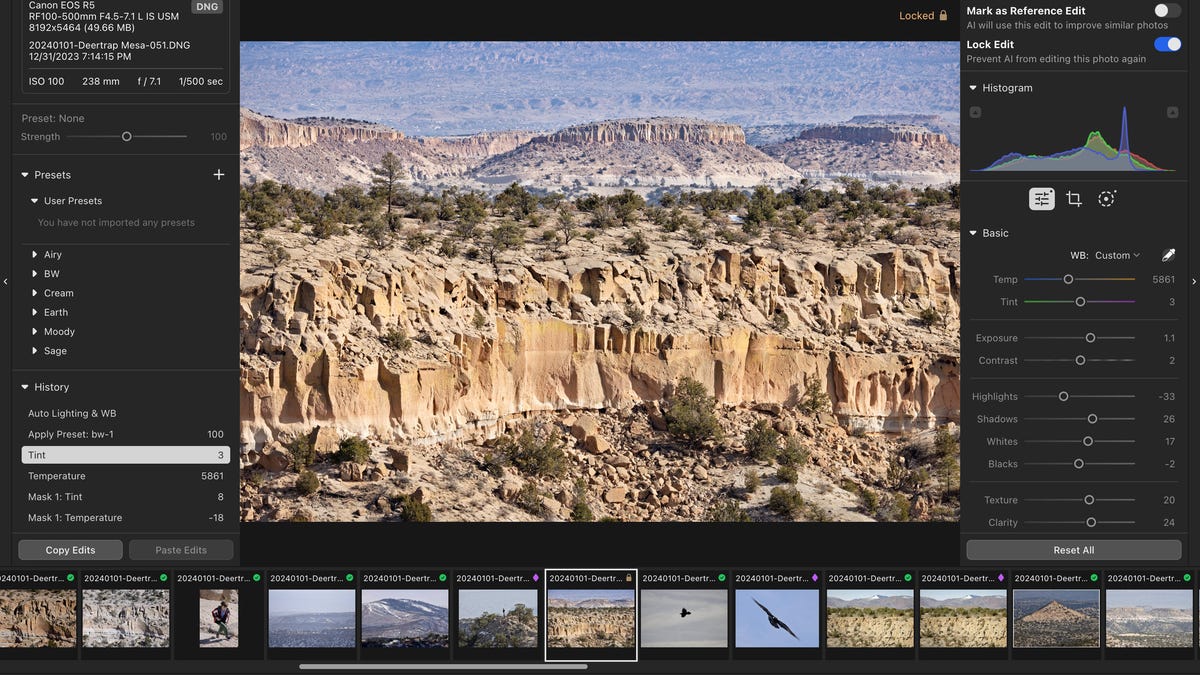I Edited Photos Using a Lightroom Competitor With a Clever New AI Trick
Polarr Next is a web app that learns how you edit and automatically updates photos to follow your style.

Polarr Next is a web-based photo editing tool that will look familiar to Adobe Lightroom users.
There's plenty of AI built into Lightroom, but a photo-editing competitor called Polarr Next hopes to get ahead with an application of the technology Adobe hadn't thought of yet. Its Lightroom clone learns from how you edit photos to try to anticipate what you want and apply that to other shots.
Lightroom, widely used among professional and enthusiast photographers, employs AI for tasks like removing noise, taking its best shot at exposure and other editing settings, and selecting people or other subjects. That's all useful, but software that can learn from your edits and know what you want to do is arguably more important.
The company launched version 1.0 of its Polarr Next software for beta testing on Monday. I gave it a whirl, and it works: I created a particular look for the pale orange mesas of Los Alamos, New Mexico, marked it as a "reference edit," and watched the look spread to similar photos from the same shoot.
"As you train this AI more and more, it will remember and then be able to reapply that again and again down the road," said Polarr Chief Executive Borui Wang said in an exclusive interview.
That kind of automation holds a lot of potential for people like wedding photographers, who are under fierce pressure to edit hundreds of photos on a tight deadline. And that kind of help is why so many developers are racing to embrace artificial intelligence.
Wang and his developers have convinced some early customers — professional wedding and portrait photographers who are the company initial market — to sign up for a $600 annual subscription to the software.
"That's around five times more expensive than Lightroom, and these are people who have been using Lightroom for over a decade," Wang said. But they wanted something that would let them get finished JPEGs to their clients sooner, he added. "They've been just so tired about the slowness."
Polarr has put some thought into its AI abilities. You can start with a variety of presets from the company, and you can create multiple AI-trained presets of your own by spawning a short photo-editing sessions to teach a new style to the app. If you don't want these dynamic styles updating photos you've already edited to your taste, you can lock individual shots to prevent future changes.
Editing photos in a web app
Notably, Polarr Next is a web application running in a browser. It's compatible with Google Chrome and similar browsers based on the Chromium project. Browser infrastructure like Web Assembly, WebGPU and WebGL make it possible, Wang said.
I'm amazed at what's possible in a browser these days. Rendering full-size versions of my 45-megapixel photos was a notch faster than in Lightroom on my two-year-old MacBook Pro. The tools to adjust exposure, contrast, white balance, clarity, color saturation, and other parameters were responsive and fluid.
Ordinary folks needn't worry about such techie underpinnings, but some web app advantages are easily visible. Polarr can update its app frequently, and the new version just arrives without any laborious installation and update rigamarole. And it's easy to try for the first time.
There's a big complication, though: Polarr Next edits photos stored on your Mac or Windows computer's local storage system. It doesn't take long to import those photos into a new project, but they're not stored in the cloud. This isn't like Gmail or Slack where you can log in from any machine and get access to your files.
Lightroom still is more mature
And you won't be confusing Polarr Next with Lightroom. Though it reproduces many of its editing features, including masks, color grading and geometric transformations, it's also missing other features. That includes the ability to merge multiple photos into a high dynamic range image or to use a healing brush to retouch parts of the image.
And catalog management tools, like the ability to write captions and sift photos into collections, is wholly absent.
But Polarr Next so far is a beta test of version 1.0 product, so there's plenty of room to improve, but already it's showing a few tricks Adobe can't manage.
Editors' note: CNET is using an AI engine to help create some stories. For more, see this post.

